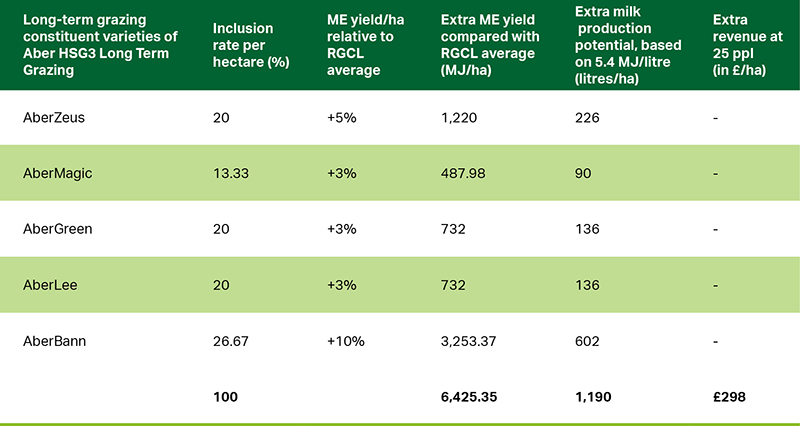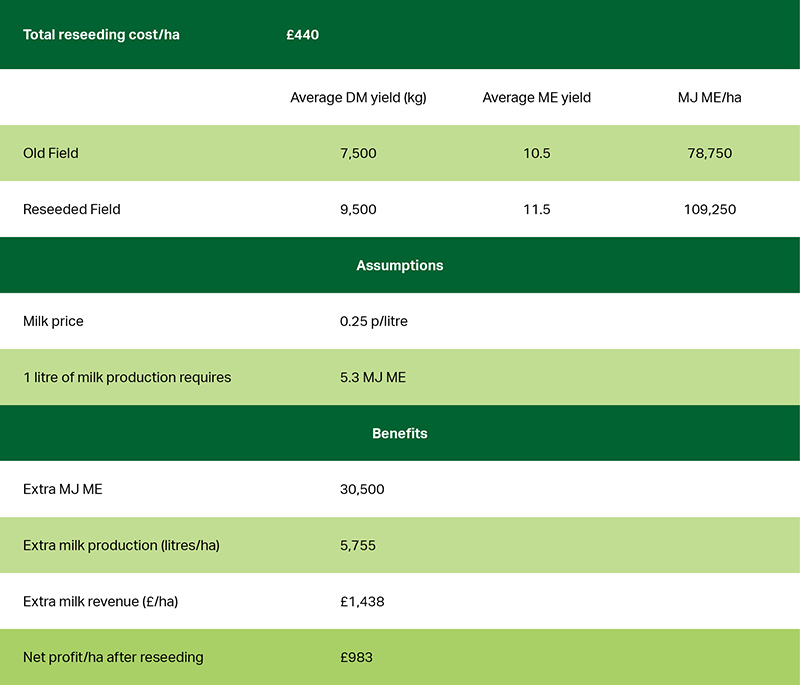Winter feeding helps to concentrate the mind when it comes to the cost and value of dairy feed. High quality forage is the cornerstone of efficient production for most UK systems. Moving the emphasis from quantity to focus on quality is key to enhancing the production potential of each ley, says National Agricultural Sales Manager, Ben Wixey.
When looking to develop the production potential of leys and increase milk volumes, improving the metabolisable energy (ME) yield per hectare is vital. Good grazing covers and dry matter tonnage in the clamp is important, but the real win in terms of milk production comes from increasing the ME yield. It means you have the best energy output possible from your grass and helps unlock those extra, cost-effective, litres from forage.
Maintaining quality
Good management and replacing older leys are two important aspects of keeping your swards performing as well as they can.
High-quality leys produce the best ME yields, but must be well managed. Simply drilling a good quality seed isn’t enough. The right management across the growing season has a huge positive impact on ME yields. A good slurry and fertiliser plan, as well as a grazing plan and harvesting at the right time for the grass plant, drives ME. Putting grazing cattle in at the right grass covers and taking them out when they hit target residual drives quality across the whole growing season. The move towards a multi-cut approach to grass silage, where grass is cut more often across the season in order to produce a higher quality crop, has also helped drive yield from forage on many dairy farms.
Over time, however, good management isn’t enough. As leys mature the level of perennial ryegrass decreases, being replaced by indigenous species such as annual meadow grass, rough stalked meadow grass and Yorkshire fog.
Research shows indigenous species have lower tonnage and ME yields. This impacts the production potential, affecting milk yields and increasing the need for supplementary feeding.
Table 1 - Effect of ley age on yield, quality and milk production (source: DairyCo)

As the table shows, even small decreases can have financial implications. A decrease in yield from 13.0 to 12.5 DM/ha, combined with a reduction in ME from 12.0 to 11.8 ME/kg DM can result in lost revenue of £401 per hectare.
Considering a reseed
You can’t substitute poor quality grass with increased quantities and maintain the same level of production. Regular reseeding helps ensure cows gain the most from grass and maintain good levels of milk production.
Despite the initial outlay, the cost of reseeding needs to be weighed up against the benefits it can bring. Compare the average DM and ME yields of your current ley, with the potential of a new ley, as well as the increased revenue from higher milk yields. In most cases a reseed is likely to see a return on investment within the first year, with higher returns for more mature leys.
Table 2 - Benefits of reseeding in terms of increased milk yields
 Choosing the right varieties
Choosing the right varieties
Picking the right seed varieties is important. If you don’t start with the best varieties you can’t achieve the best results. Choose varieties from the recommended grass and clover lists (RGCL 2020-2021) and look for those with the highest ME yields per hectare, ie. those which are high yielding with good quality. Again, even small differences in ME can have a substantial impact on the amount of milk produced.
Table 3 compares the ME yield figures for the Aber HSG varieties found in the popular grazing mixture, Aber HSG3 Long Term Grazing, with the average ME yield of all perennial ryegrasses listed in the RGCL. The Aber HSG varieties used in this mixture offer an ME yield 3-10% above average.
Table 3 - Effect of higher ME-yielding grass varieties on production potential

To find out more about the value of ME and choosing the right mixture for your next reseed, contact Ben Wixey on 07990 578550.
“We’ve spent the last five years reseeding and replacing the farm’s older grass leys. These renewed leys now provide five or six cuts of grass each year and silage that consistently achieves values of 12% ME, 30-40% DM and 17-20% crude protein.” James Evans, dairy farmer, Mid-Wales

